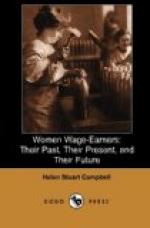In spite of this, certain trades were practically woman’s. Embroidery of church vestments and hangings had been brought to the highest perfection. Lace-making had been known from the most ancient times; and Colbert, the famous financier and minister for Louis XIV., gave a privilege to Madame Gilbert, of Alencon, to introduce into France the manufacture of both Flemish and Venetian Point, and placed in her hands for the first expenses 150,000 francs. The manufacture spread over every country of Europe, though in 1640 the Parliament of Toulouse sought to drive out women from the employment, on the plea that the domestic were her only legitimate occupations. A monk came to the rescue, and demonstrated that spinning, weaving, and all forms of preparing and decorating stuffs had been hers from the beginning of time, and thus for a season averted further action.
The monk had learned his lesson better than most of the workmen who sought to curtail woman’s opportunities. In the chronicles of that time there is full description of the workshops which formed part of every great estate, that known as the gynaeceum being devoted to the women and children, who spun, wove, made up, and embroidered stuffs of every order. The Abbey of Niederalteich had such a gynaeceum, in which twenty-two women and children worked, while that of Stephenswert employed twenty-four; co-operation in such labor having been found more advantageous than isolated work. Before the tenth century these workshops had been established at many points. If part of a feudal manor, the wife of its lord acted often as overseer; if attached to some abbey, a general overlooker filled the same place. In the convents manual labor came into favor; and the spinning, weaving, and dyeing of stuffs occupied a large part of the life.
Apprenticeship for both male and female was finally well established, and many women became the successful heads of prosperous industries. The wage was, as it is to-day, the merest pittance; but any wage whatever was an advance upon the conditions of earlier servitude.
Life had small joy for women in those days we call the “good old times.” Take the married woman, the house-mother of that period. She not only lived in the strictest retirement, but her duties were so complex and manifold that, to quote Bebel, “a conscientious housewife had to be at her post from early in the morning till late at night in order to fulfil them. It was not only a question of the daily household duties that still fall to the lot of the middle-class housekeeper, but of many others from which she has been entirely freed by the modern development of industry, and the extension of means of transport. She had to spin, weave, and bleach; to make all the linen and clothes, to boil soap, to make candles and brew beer. In addition to these occupations, she frequently had to work in the field or garden and to attend to the poultry and cattle.




